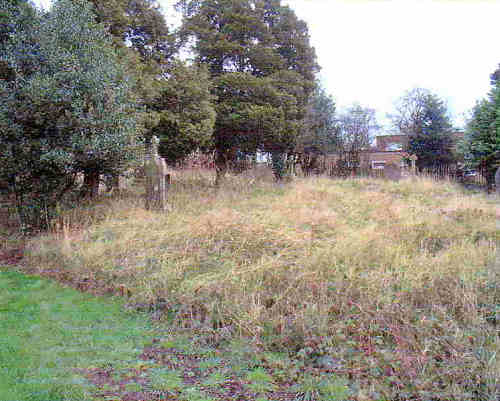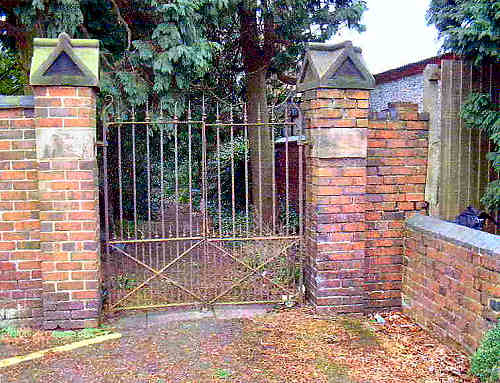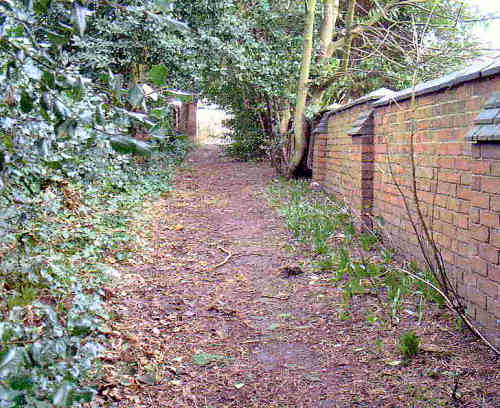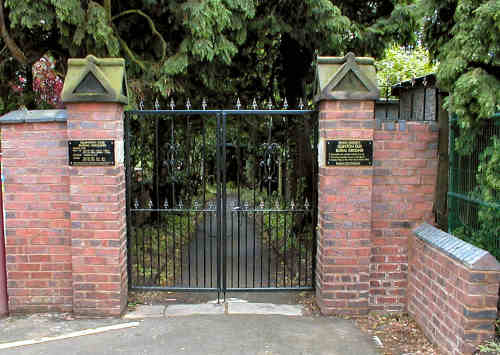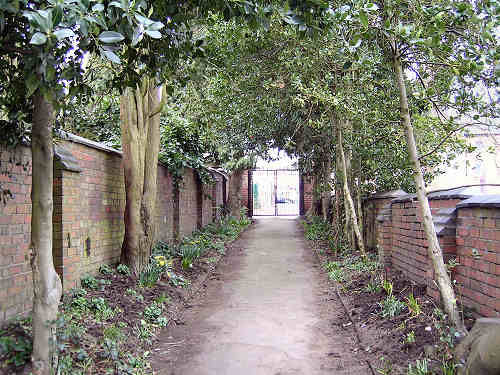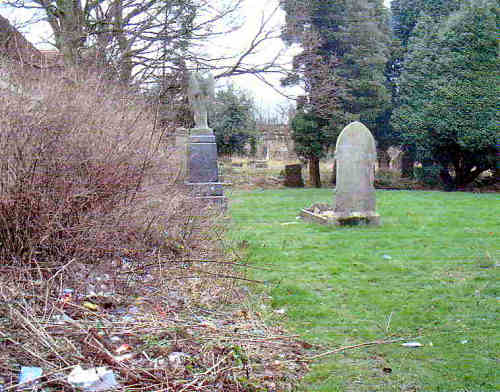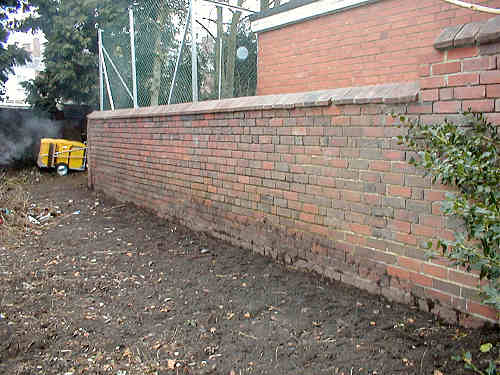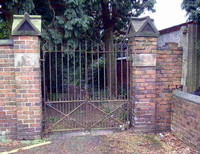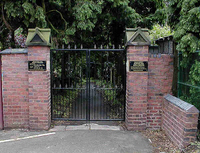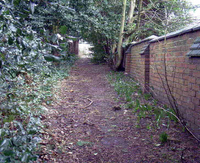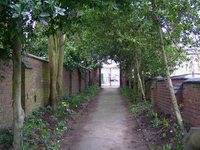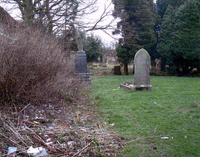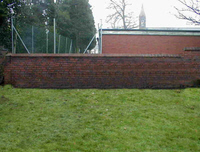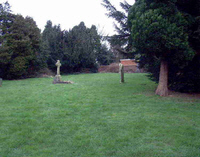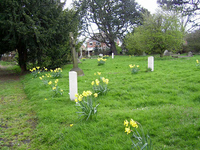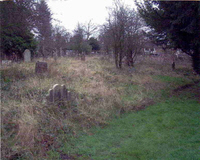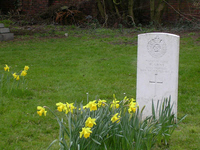Quinton Burial GroundI have been promising for some time to include an article about the Old Burial Ground in Quinton that is situated off Hagley Road West and at the end of the tarmac drive that runs between the church and ‘Humberstones’ estate agents. In case anyone is unfamiliar with the area or was unaware that such a place existed here is a short passage from the T W Bunting book (recently re printed by the society) that explains how the site began. In February 1889, the CHURCHYARD was closed to interments by an order in Council. To that date, and from the year of its consecration, 1840, 1415 persons had been buried there. In due course the Churchyard was “put in proper condition” and it was decreed that all future costs for its maintenance be met by the Overseers of the Parish. A few months after the closure the Rector and Wardens conveyed, Alexander Macomb Chance, for the sum of £158, one acre of glebe land - to be used as a NEW BURIAL GROUND. Mr. Chance divided the land and conveyed the western half to Mr. Arthur Albright in consideration of £83; he, in turn, gave over this area to certain non-conformist trustees on the firm proviso that it should remain unconsecrated "for the burial of all persons for whom therein application shall be made". The eastern half of the land was consecrated by the Bishop of Worcester on 30 August 1890, one-sixth of this half-acre being appropriated by Mr. Chance as a private burial ground, and the whole to be exclusive to parishioners of any religious persuasion. The unconsecrated ground, totalling 476 grave spaces, could be used for non-parishioners on payment of a fee, and by 1903 a few church people (i.e. C. of E.) from outside the Parish had been buried there - fully in accord with the conditions set out in the gift of the land. However, at this time the non-conformist trustees revoked their agreement with Mr. Albright and refused to allow any further interments of members of the Church of England. “ We protest against this Resolution as being an infringement of the rights of churchmen who have the legal right to be interred in any portion of the Parish Burial Ground”- wrote the Rector, but it was all to no avail as the trustees remained adamant. A final appeal was made to the Home Office a year later; their response was that the interpretation of Trust Deeds was not for them to decide. The Rector was prepared to sell more glebe land to extend the ground but, with the Bishop, was of the opinion that this additional provision was really the duty of the civil authority and not the Church. There the matter rested. Quinton Cemetery was opened in the 1920's, and in 1936 the Chance family gave up part of the burial ground reserved for them, and this allowed for a further 15-20 graves. The Burial ground has a central path, and the Church, or consecrated side is the eastern half, on the left of the path; the Chapel side is the western half, on the right. The Church side was administered by the Rector and Church Council, as is usual; the Chapel side was administered by a body of Free Churchmen, known as the Trustees, who employed a firm of solicitors to act as their clerk and keep them on the right lines.
The site was overgrown and uncared for. To be honest apart from the time given by certain church incumbents and various sums of money that were found to tidy the area, the area was forgotten and becoming a burden to the community.
The history society began in 1999 with one of it’s main constitutional aims being to preserve and archive the history of Quinton. After the successful project to restore the “Bourne College War Memorial” etc. I decided that this was such a significant part of Quinton’s history that it merited the society’s attention. It has been an ongoing and time-consuming project, with the feeling in the early days that I was hitting my head against a brick wall. Bids were placed before various organisations asking for funding towards the project but alas no one wanted to know. Then 2003 I was delighted to hear of a “Pot of Money” for local projects, “a chance to give money back to the area for it’s loss of green open spaces”. A bid was put together and SUCCESS! a £5000 grant from Quinton Meadows Capital Receipt, the work began. The photos above show the area prior to clearance work and below the entrance from the ground to the old gates.
The problem I had was that everywhere was overgrown, the pathways that are visible now were below this earth and vegetation. The gates and pillars were over 100 years old and in a poor state of repair. There was little or no security and the area, believe or not, was a target for drugs and drinking and anti-social behaviour in general. Well the plan was simply as follows:
Above all the area should be tended for and made once more into an area for Quintonians to be proud of. The work began, contractors were employed to carry out the work and with six months the project was beginning to take shape. Members of the society have helped, especially Jean and Barry Sunderland, who have spent many hours at the site tidying and planting bulbs, shrubs and trees. Funding has always been a problem. However, thanks to the kindness shown by certain society members, who shall remain anonymous (but they know who they are) and a few modest collections at meetings we managed to keep up the good work. The society has contributed small amounts out of the profits of functions, exhibitions etc. Other people have given bulbs, plants and shrubs. Following are a few photographs showing the work undertaken since 2002 until 2004/5.
The work has continued but my dream has always been to erect a “Garden of Remembrance” within the burial ground. An area for quiet thoughts and a chance to remember loved ones no longer with us. The wall at the rear of the burial ground to hopefully house memorial plaques and the seated area to have stone planters. A fitting tribute to the folk of Quinton both past and present. This will also create disabled access from the one pathway to the central pathway that divides the two sides of the burial ground. The memorial plaques don’t have to be for those buried here but for anyone who was associated with The Quinton. To enable me to do this I applied for funding from various sources but again, to its credit, Birmingham City Council using funds from the Community Chest for NRF Funding has agreed to fund the work. Councillors Jane James, Len Clark and Richard Bashford have been helpful in obtaining funding to continue the good work. The work has begun, already the wall designated as the memorial wall has been pointed and the land in front cleared.
The funding is in place for most of the work and I hope that the “Garden of Remembrance will be in place by the end of April/May 2006. The wall with memorial plaques will be available shortly after that date. If anyone is interested in renting space for a plaque to a loved one in the burial ground or church cemetery then please make contact with me, I will be pleased to give you the full details and cost. My dream looks as if it may come true and I am so pleased. This area is a significant part of Quinton’s history. Many names synonymous with Quinton’s past are laid to rest in this very small but peaceful area. The trust has moved on since it held its first meeting on 11th December 1890, following are some minutes taken from the minute book, which is now in the possession of the Trust’s solicitor. First meeting held at Mr Godlee’s office at No.4 Bennetts Hill, Birmingham on 11th December, 1890.
In 1968 the Chairman reminded the meeting that the loan made to Lancashire C. C. was due for repayment. It was resolved that the £500 be re-invested for a further 3 years.
Press CuttingsArticle 1Article 2 Article 3
Click here to go back to the Conservation page. | ||||||||||||||||||||||||||||||||||||||||

